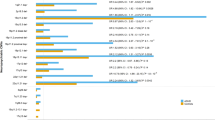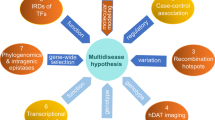Abstract
Attention deficit hyperactivity disorder (ADHD) is a common childhood-onset neurodevelopmental disorder. Evidence from twin, adoption, and family studies provide support for a genetic contribution to the etiology of ADHD. Several candidate gene studies have identified an association between a 7-repeat variant in exon 3 of the dopamine 4 receptor gene (DRD4) and ADHD. However, in spite of the positive reports finding association of the exon 3 VNTR with ADHD, several other polymorphisms within DRD4 have been identified that conceivably could contribute to risk for ADHD. Recently, another common polymorphism of the DRD4 gene has been described involving a 120-bp repeat element upstream of the 5′ transcription initiation site. In this report, we describe results of analysis of the DRD4 120-bp repeat promoter polymorphism in a sample of 371 children with ADHD and their parents, using the transmission disequilibrium test (TDT). Results showed a significant preferential transmission of the 240-bp (long) allele with ADHD. Exploratory analyses of the Inattentive phenotypic subtype of ADHD strengthened the evidence for linkage. These data add further support for the role of DRD4 variants conferring increased risk for ADHD, and imply that additional studies of DRD4 and other related genes are needed.
This is a preview of subscription content, access via your institution
Access options
Subscribe to this journal
Receive 12 print issues and online access
$259.00 per year
only $21.58 per issue
Buy this article
- Purchase on Springer Link
- Instant access to full article PDF
Prices may be subject to local taxes which are calculated during checkout
Similar content being viewed by others
References
Thapar A, Holmes J, Poulton K, Harrington R . Genetic basis of attention deficit and hyperactivity Br J Psychiatry 1999; 174: 105–111
Faraone SV, Biederman J . Genetics of attention-deficit hyperactivity disorder Child Adolesc Clin North Am 1994; 3: 285–291
Biederman J, Faraone SV, Keenan K, Benjamin J, Krifcher B, Moore C et al. Further evidence for family-genetic risk factors in attention deficit hyperactivity disorder Arch Gen Psychiatry 1992; 49: 728–738
Hudziak J, Heath AC, Madden PF, Reich W, Bucholz KK, Slutske W et al. Latent class and factor analysis of DSM-IV ADHD: a twin study of female adolescents J Am Acad Child Adolesc Psychiatry 1998; 37: 848–857
Levy F, Hay DA, McStephen M, Wood C, Waldman I . Attention-deficit hyperactivity disorder: category or continuum? Genetic analysis of a large-scale twin study J Am Acad Child Adolesc Psychiatry 1997; 36: 737–744
Sherman DK, Iacono WG, McGue MK . Attention-deficit hyperactivity disorder dimensions: a twin study of inattention and impulsivity-hyperactivity J Am Acad Child Adolesc Psychiatry 1997; 36: 745–753
Seeman P, Madras BK . Anti-hyperactivity medication: methylphenidate and amphetamine Mol Psychiatry 1998; 3: 386–396
Sobell JL, Heston LL, Sommer SS . Delineation of genetic predisposition to multifactorial disease: a general approach on the threshold of feasibility Genomics 1992; 12: 1–6
Collier DA, Sham PC . Catch me if you can: are catechol- and indolamine genes pleotropic QTLs for common mental disorders? Mol Psychiatry 1997; 2: 181–183
Swanson JM, Flodman P, Kennedy J, Spence MA, Moyzis R, Schuck S et al. Dopamine genes and ADHD Neurosci Biobehav Rev 2000; 24: 21–25
Volkow ND, Wang GJ, Fowler JS, Fischman M, Foltin R, Abumrad N et al. Methylphenidate and cocaine have a similar in vivo potency to block dopamine transporters in the human brain Life Sci 1999; 65: PL 7–12
Lichter JB, Barr CL, Kennedy JL, Van Tol HHM, Kidd KD, Livak KJ . A hypervariable segment in the human dopamine receptor (DRD4) gene Hum Mol Genet 1993; 2: 767–773
Asghari V, Schoots O, van Kats S, Ohara K, Jovanovic V, Guan HC et al. Dopamine D4 receptor repeat: analysis of different native and mutant forms of the human and rat genes Mol Pharmacol 1994; 46: 364–373
Asghari V, Sanyal S, Buchwaldt S, Paterson A, Jovanovic V, Van Tol HHM . Modulation of intracellular cyclic AMP levels by different human dopamine D4 receptor variants J Neurochem 1995; 65: 1157–1165
Jovanovic V, Guan HC, Van Tol HH . Comparative pharmacological and functional analysis of the human D4.2 and D4.10 receptor variants Pharmacogenetics 1999; 9: 561–568
Benjamin J, Li L, Patterson C, Greenberg BD, Murphy DL, Hamer DH . Population and familial association between the D4 dopamine receptor gene and measures of Novelty Seeking Nature Genet 1996; 12: 81
Ebstein RP, Novick O, Umansky R, Priel B, Osher Y, Blaine D et al. Dopamine D4 receptor (D4DR) exon III polymorphism associated with the human personality trait of Novelty Seeking Nature Genet 1996; 12: 78–88
Ekelund J, Lichtermann D, Jarvelin MR, Peltonen L . Association between novelty seeking and the type 4 dopamine receptor gene in a large Finnish cohort sample Am J Psychiatry 1999; 156: 1453–1455
Grice DE, Leckman JF, Pauls DL, Kurlan R, Kidd KK, Pakstis AJ et al. Linkage disequilibrium between an allele at the dopamine D4 receptor locus and Tourette syndrome, by the transmission-disequilibrium test Am J Hum Genet 1996; 59: 644–652
Cruz C, Camarena B, King N, Paez F, Sidenberg D, de la Fuente JR et al. Increased prevalence of the seven-repeat variant of the dopamine D4 receptor gene in patients with obsessive-compulsive disorders with tics Neurosci Lett 1997; 231: 1–4
Petronis A, Macciardi F, Athanassiades A, Paterson AD, Verga M, Mel HY et al. Association study between dopamine D4 receptor gene and schizophrenia Am J Med Genet 1995; 60: 452–455
LaHoste GJ, Swanson JM, Wigal SB, Glabe C, Wigal T, King N et al. Dopamine D4 receptor gene polymorphism is associated with attention deficit hyperactivity disorder Mol Psychiatry 1996; 1: 121–124
Swanson JM, Sunohara GA, Kennedy JL et al. Association of the dopamine receptor D4 (DRD4) gene with a refined phenotype of attention deficit hyperactivity disorder (ADHD): a family-based approach Mol Psychiatry 1998; 3: 38–41
Smalley SL, Bailey JN, Palmer CG et al. Evidence that the dopamine D4 receptor is a susceptibility gene in attention deficit hyperactivity disorder Mol Psychiatry 1998; 3: 427–434
Rowe DC, Stever C, Giedinghagen LN, Gard JM, Cleveland HH, Terris ST et al. Dopamine DRD4 receptor polymorphism and attention deficit hyperactivity disorder Mol Psychiatry 1998; 3: 419–426
Faraone SV, Biederman J, Weiffenbach B, Keith T, Chu MP, Weaver A et al. Dopamine D4 gene 7-repeat allele and attention deficit hyperactivity disorder Am J Psychiatry 1999; 156: 768–770
Castellanos FX, Lau E, Tayebi N, Lee P, Long RE, Giedd JN et al. Lack of an association between a dopamine-4 receptor polymorphism and attention deficit/hyperactivity disorder: genetic and brain morphometric analyses Mol Psychiatry 1998; 3: 431–434
Frank TS, Deffenbach AM, Hulick M, Gumpper K . Hereditary susceptibility to breast cancer: significance of age of onset in family history and contribution of BRCA1 and BRAC2 Disease Markers 1999; 15: 89–92
Seaman MI, Fisher JB, Chang F-M, Kidd KD . Tandem duplication polymorphism upstream of the dopamine D4 receptor gene (DRD4) Am J Med Genet 1999; 88: 705–709
Paterson AD, Ying D-J, Petronis A, Schoots O, Lieberman JA, Van Tol HHM et al. A PstI restriction fragment length polymorphism in the 5′ untranslated region of DRD4 is not associated with schizophrenia Psychiatric Genet 1996; 6: 191–193
Kaufman J, Birmaher B, Brent D, Rao U . Schedule for affective disorders and schizophrenia for school aged children (6–18 years)—present and lifetime version (K-SADS-PL): initial reliability and validity data J Am Acad Child Adolesc Psychiatry 1997; 36: 980–988
Fyer AJ, Endicott J, Mannuzza S, Klein DF . Schedule for Affective Disorders and Schizophrenia — Lifetime Version, modified for the Study of Anxiety Disorder 1985, updated for DSM-IV (SADSLA-IV), Anxiety Genetics Unit, New York State Psychiatric Institute: New York, 1995
SAGE . Statistical Analysis for Genetic Epidemiology, Release 3.1 Computer Program package available from the Department of Epidemiology and Biostatistics, Rammelkamp Center for Education and Research, MetroHealth Campus, Case Western Reserve University, Cleveland 1997
Spielman RS, McGinnis RE, Ewens WJ . Transmission test for linkage disequilibrium: the insulin gene region and insulin-dependent diabetes mellitus (IDDM) Am J Hum Genet 1993; 52: 506–516
Risch N, Merikangas K . The future of genetic studies of complex human diseases Science 1996; 273: 1516–1517
Ott J . Linkage Analysis Package II: User's Guide to Analysis Programs. Version 5.1 for IBM PC/compatibles Columbia University 1992
SAS . SAS Procedures Guide for Personal Computers, Version 6.12 SAS Institute: Cary, NC 1996
Okuyama Y, Ishiguro H, Toru M, Arinami T . A genetic polymorphism in the promoter region of DRD4 associated with expression and schizophrenia Biochem Biophys Res Commun 1999; 258: 292–295
Smalley SL, McGough JJ, Del'Homme M, New Delman J, Gordon E, Kim T et al. Familial clustering of symptoms and disruptive behaviors in multiplex families with attention deficit hyperactivity disorder J Am Acad Child Adoles Psychiatry (in press)
Biederman J, Faraone SV, Keenan K et al. Evidence of familial association between attention deficit disorder and major affective disorders Arch Gen Psychiatry 1991; 48: 633–642
Cook EH, Stein MA, Krasowski MD, Cox NJ, Olkon DM, Keiffer JE et al. Association of attention-deficit disorder and the dopamine transporter gene Am J Hum Genet 1995; 56: 993–998
Acknowledgements
This paper is dedicated to the memory of Dennis P Cantwell, MD. The authors also extend their appreciation to the families for their participation. The helpful contributions of T Kim, J NewDelman, E Gordon, E Carr, E Cantwell, and A Woodward are gratefully appreciated. Some of the results of the paper were obtained with the use of SAGE, which is supported by a US PHS Service Resource Grant (P41 RR03655) from the National Center for Research Resources. The project was supported by NIH grant MH 58277 (SLS) and the UCLA Tourette Syndrome Research Fund (JTM).
Author information
Authors and Affiliations
Corresponding author
Rights and permissions
About this article
Cite this article
McCracken, J., Smalley, S., McGough, J. et al. Evidence for linkage of a tandem duplication polymorphism upstream of the dopamine D4 receptor gene (DRD4) with attention deficit hyperactivity disorder (ADHD). Mol Psychiatry 5, 531–536 (2000). https://doi.org/10.1038/sj.mp.4000770
Received:
Revised:
Accepted:
Published:
Issue Date:
DOI: https://doi.org/10.1038/sj.mp.4000770
Keywords
This article is cited by
-
Dopamine Receptor Expression and the Pathogenesis of Attention-Deficit Hyperactivity Disorder: a Scoping Review of the Literature
Current Developmental Disorders Reports (2022)
-
DRD4 48 bp multiallelic variants as age-population-specific biomarkers in attention-deficit/hyperactivity disorder
Translational Psychiatry (2020)
-
Methylation-related metabolic effects of D4 dopamine receptor expression and activation
Translational Psychiatry (2019)
-
ADHD risk alleles associated with opiate addiction: study of addicted parents and their children
Pediatric Research (2016)
-
Decreasing ADHD phenotypic heterogeneity: searching for neurobiological underpinnings of the restrictive inattentive phenotype
European Child & Adolescent Psychiatry (2016)



